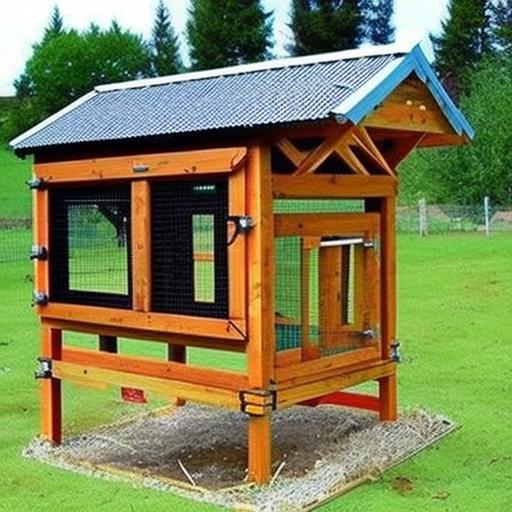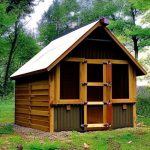Raising chickens has become increasingly popular in recent years, and for good reason. Not only do chickens provide a sustainable source of fresh eggs, but they also offer a range of other benefits. Building your own chicken coop allows you to take advantage of these benefits while also saving money and experiencing the personal satisfaction of a DIY project.
One of the main benefits of raising chickens is the access to fresh eggs. By having your own flock, you can ensure that the eggs you consume are free-range, organic, and of the highest quality. Additionally, chickens are great for pest control as they eat insects and other pests that can damage your garden. They also produce nutrient-rich manure that can be used as fertilizer for your plants.
Building your own chicken coop also offers significant cost savings compared to purchasing a pre-made coop. While pre-made coops can be convenient, they often come with a hefty price tag. By building your own coop, you have the opportunity to save money and customize the design to meet your specific needs.
Furthermore, building your own chicken coop can be a rewarding and fulfilling DIY project. It allows you to exercise your creativity and craftsmanship while providing a safe and comfortable home for your chickens. The sense of accomplishment that comes from completing a project like this is unmatched, and you’ll have a functional and attractive coop to show for it.
Key Takeaways
- Building your own chicken coop can save you money and provide a fun DIY project.
- When planning your coop, consider factors such as size, ventilation, and predator protection.
- Choose a location that is safe, dry, and provides access to sunlight and shade.
- Gather materials such as lumber, wire mesh, and tools like a saw and drill.
- Follow a step-by-step guide to construct your coop, adding features like nesting boxes and roosting bars.
- Keep your chickens safe and healthy by providing proper food, water, and cleaning routines.
- Regular maintenance such as cleaning and repairs will keep your coop in good condition.
- Additional considerations include winterizing your coop and protecting against predators.
- Enjoy the benefits of fresh eggs and happy, healthy chickens with your DIY coop.
Planning Your Frame Chicken Coop: Factors to Consider
Before you start building your chicken coop, it’s important to carefully plan out the design and consider several factors. The size of the coop should be based on the number of chickens you plan to have. Each chicken requires about 4 square feet of space inside the coop and 10 square feet in the outdoor run area. It’s important to provide enough space for the chickens to move around comfortably.
Another factor to consider is the type of chickens you will be raising and their specific needs. Different breeds have different requirements in terms of space, temperature, and ventilation. Some breeds are more cold-hardy, while others are better suited for warmer climates. Research the specific needs of the chickens you plan to raise and design your coop accordingly.
Climate and weather conditions also play a role in the design of your chicken coop. If you live in an area with extreme temperatures, you may need to insulate the coop or provide additional heating or cooling options. Consider the prevailing winds and position the coop in a way that provides protection from harsh weather conditions.
Choosing the Right Location for Your Coop
The location of your chicken coop is crucial for the health and well-being of your chickens. It’s important to choose a level and well-drained area for the coop. This will prevent water from pooling around the coop and causing dampness, which can lead to health issues for the chickens.
Access to sunlight is also important for the chickens’ overall health. Choose a location that receives ample sunlight throughout the day, as this will help keep the coop dry and provide natural warmth. However, it’s also important to provide shade options within the coop to protect the chickens from excessive heat during the summer months.
Proximity to your home and water source is another factor to consider when choosing a location for your coop. Having the coop close to your home makes it easier to monitor and care for the chickens on a daily basis. Additionally, having a water source nearby will make it more convenient to provide fresh water for the chickens on a regular basis.
Materials and Tools You’ll Need for Your DIY Chicken Coop
| Materials | Tools |
|---|---|
| Wooden boards | Hammer |
| Chicken wire | Saw |
| Nails | Drill |
| Hinges | Screwdriver |
| Roofing material | Measuring tape |
| Paint or stain | Level |
| Hardware cloth | Wire cutters |
When building your own chicken coop, you’ll need a variety of materials and tools to complete the project. The materials you’ll need include lumber for framing, plywood for walls and roof, hardware cloth for windows and ventilation, roofing material, screws or nails, hinges, and latches. It’s important to choose materials that are durable and weather-resistant to ensure the longevity of your coop.
In terms of tools, you’ll need a circular saw or miter saw for cutting lumber, a drill for making holes and attaching hardware, a tape measure for accurate measurements, a level for ensuring everything is straight and level, and a hammer or screwdriver for assembling the coop. Having the right tools on hand will make the construction process much smoother and more efficient.
When it comes to sourcing affordable materials, there are several options to consider. Look for local lumberyards or home improvement stores that offer discounted or reclaimed materials. You can also check online marketplaces or classified ads for used materials that are still in good condition. Additionally, consider repurposing materials from other projects or buildings to save money.
Step-by-Step Guide to Building Your Own Frame Chicken Coop
Now that you have your materials and tools ready, it’s time to start building your chicken coop. Here is a step-by-step guide to help you through the process:
1. Start by building the frame of the coop using the lumber. Cut the pieces according to your design and assemble them using screws or nails. Make sure everything is square and level.
2. Once the frame is complete, attach plywood sheets to the walls and roof using screws or nails. Leave openings for windows and ventilation.
3. Install windows and ventilation using hardware cloth to keep predators out while allowing for proper airflow.
4. Build a door for easy access to the coop. Attach hinges and a latch to secure it.
5. Add a roof using roofing material of your choice. Make sure it is securely attached and provides proper protection from the elements.
6. Finish off the coop by adding any additional features you desire, such as nesting boxes, roosting bars, and ramps.
Adding Features: Nesting Boxes, Roosting Bars, and More

To make your chicken coop functional and comfortable for your chickens, it’s important to add certain features. Nesting boxes are essential for egg-laying chickens. These boxes provide a safe and private space for the hens to lay their eggs. The size and number of nesting boxes will depend on the number of chickens you have. Aim for one nesting box per 3-4 hens.
Roosting bars are another important feature to consider. Chickens naturally roost at night, so providing them with a designated space to do so is crucial. Roosting bars should be placed higher than the nesting boxes and should be wide enough for the chickens to comfortably perch on.
Other features to consider include proper ventilation and lighting. Good ventilation is important for maintaining air quality and preventing the buildup of moisture and ammonia. Install vents or windows that can be opened and closed as needed. Lighting can also be beneficial, especially during the winter months when daylight hours are shorter. Consider installing a light source that mimics natural daylight to keep the chickens active and productive.
Tips for Keeping Your Chickens Safe and Healthy
Once your chicken coop is built, it’s important to take proper care of your chickens to ensure their safety and health. Regular cleaning and maintenance are crucial for preventing the spread of diseases and parasites. Clean out the coop on a regular basis, removing any bedding, droppings, or debris. Disinfect the coop periodically using a poultry-safe disinfectant.
Preventing common health issues in chickens starts with providing a clean and comfortable living environment. Make sure the coop is well-ventilated to prevent respiratory issues. Provide fresh water daily and ensure that it is easily accessible to the chickens. Additionally, provide a balanced diet that includes a mix of commercial feed, fresh greens, and kitchen scraps.
It’s also important to monitor your chickens for any signs of illness or injury. Regularly check their feathers, eyes, beaks, and feet for any abnormalities. If you notice any signs of illness or injury, consult a veterinarian who specializes in poultry health.
Maintaining Your Frame Chicken Coop: Cleaning and Repairs
Regular maintenance of your chicken coop is essential for its longevity and the well-being of your chickens. Cleaning the coop on a regular basis will help prevent the buildup of bacteria and parasites. Remove any bedding, droppings, or debris and disinfect the coop using a poultry-safe disinfectant. Allow the coop to dry thoroughly before adding fresh bedding.
Common repairs that may be needed include fixing loose or broken boards, replacing damaged roofing material, and repairing or replacing doors and windows. Regularly inspect the coop for any signs of wear and tear and address any issues promptly to prevent further damage.
In addition to regular cleaning and repairs, it’s important to conduct regular inspections of the coop to ensure that it remains secure and predator-proof. Check for any gaps or holes that could allow predators to enter the coop. Reinforce any weak areas and make sure all doors and windows are securely closed.
Additional Considerations: Winterizing Your Coop, Predator Protection, and More
As the seasons change, there are additional considerations to keep in mind when it comes to your chicken coop. Winterizing your coop is important to protect your chickens from cold temperatures and harsh weather conditions. Insulate the coop using straw or other insulating materials. Provide additional bedding for warmth and consider using a heat lamp if necessary. Make sure the coop is well-ventilated to prevent condensation buildup.
Predator protection is another important consideration when it comes to keeping your chickens safe. Secure the coop with sturdy fencing that extends underground to prevent digging predators from entering. Install locks on doors and windows to prevent raccoons, foxes, or other predators from gaining access.
It’s also important to familiarize yourself with any zoning laws or permits that may be required for keeping chickens in your area. Some municipalities have restrictions on the number of chickens allowed or require permits for keeping them. Make sure you are in compliance with any local regulations to avoid any legal issues.
Enjoying the Fruits of Your Labor with Happy, Healthy Chickens.
Building your own chicken coop is a rewarding and fulfilling project that offers a range of benefits. By raising your own chickens, you can enjoy fresh eggs, pest control, and nutrient-rich manure for your garden. Building your own coop allows you to save money and customize the design to meet your specific needs.
Throughout the process, it’s important to plan carefully, choose the right location, and use quality materials and tools. Adding features such as nesting boxes and roosting bars will make your coop functional and comfortable for your chickens. Taking proper care of your chickens by providing a clean and healthy environment will ensure their safety and well-being.
Regular maintenance and inspections are crucial for the longevity of your coop. Cleaning, repairs, and predator protection should be prioritized to keep your chickens safe and secure. By following these guidelines, you can enjoy the fruits of your labor with happy, healthy chickens and experience the joys of homesteading.
If you’re looking for a comprehensive guide on building a frame chicken coop, then you should check out the article on Poultry Wizard titled “A-Frame Chicken Coop: The Perfect Home for Your Flock.” This article provides detailed plans and instructions in a convenient PDF format, making it easy for anyone to construct their own chicken coop. Whether you’re a beginner or an experienced DIY enthusiast, this resource will help you create a sturdy and functional coop that will keep your chickens safe and comfortable. Don’t miss out on this valuable resource – click here to access the article now.
FAQs
What is a frame chicken coop?
A frame chicken coop is a type of chicken coop that is built using a simple frame structure. It is usually made of wood and wire mesh and is designed to provide shelter and protection for chickens.
What are the benefits of using a frame chicken coop?
A frame chicken coop is a cost-effective and easy-to-build option for those who want to keep chickens. It provides a safe and secure environment for chickens to live in, protects them from predators, and allows them to roam freely.
What are the key features of a frame chicken coop?
A frame chicken coop typically consists of a wooden frame, wire mesh walls, a roof, and a door. It may also include nesting boxes, roosting bars, and a ramp for the chickens to enter and exit the coop.
What materials are needed to build a frame chicken coop?
To build a frame chicken coop, you will need wood, wire mesh, roofing material, screws, nails, and basic tools such as a saw, hammer, and drill.
Are there any plans available for building a frame chicken coop?
Yes, there are many plans available for building a frame chicken coop. These plans can be found online or in books and typically include detailed instructions, diagrams, and a list of materials needed.
Is it difficult to build a frame chicken coop?
Building a frame chicken coop is not difficult, but it does require some basic carpentry skills and tools. With the right plans and materials, anyone can build a frame chicken coop in a weekend or two.
Meet Walter, the feathered-friend fanatic of Florida! Nestled in the sunshine state, Walter struts through life with his feathered companions, clucking his way to happiness. With a coop that’s fancier than a five-star hotel, he’s the Don Juan of the chicken world. When he’s not teaching his hens to do the cha-cha, you’ll find him in a heated debate with his prized rooster, Sir Clucks-a-Lot. Walter’s poultry passion is no yolk; he’s the sunny-side-up guy you never knew you needed in your flock of friends!







